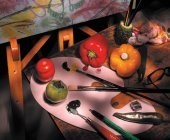|
History of photographyIdea of a pin hole camera came up way back in 4th century BC by a Chinese philosopher Mo Di, Greek mathematician Aristotle (384 BC – 322 BC) and Euclid. By 6th century AD, camera obscura (dark chamber) was used in experiments by Byzantine mathematician Anthemius of Tralles. Yet there was no practical use of this physics. Camera Obscura - a dark chamber was described by Leonardo daVinci by 1490. An upside down image formed by the light rays passing through a small hole in a dark room, was fascinating for many painters. Leonardo daVinci used this physics to trace out an upside down image on a canvas, to use it as a reference thumbnail sketch. In a way, this was the first practical camera. Silver nitrate was discovered by Albertus Magnus (1193–1280) and silver chloride was discovered by Georges Fabricius (1516–71). Yet, nobody notice the photo-chemical effect of light on these chemicals. Aperture or a diaphragm was described in 1568 by Daniele Barbaro, which can be used in a pin hole camera to control the amount of light. In 1614, Angelo Sala observed the effect of light on silver nitrate. Through years of research, by 1694, Wilhelm Homberg described the effect of light, was darkening some chemicals (photo-chemical effect). Yet, this observation had no practical use. In 1760, French author Tiphaigne de la Roche published a fiction book Giphantie, in which a 'photography' type of process was described. This imagination led towards the combined use of photo-chemical effect and a camera obscura. Wollaston fitted a lens to camera obscura in 1812 and in 1822, the French inventor Nicéphore Niépce produced first permanent image by photo etching process. By 1826, Niépce was successful with the work of photography but as the chemistry was not refined, it was taking nearly eight hours to expose one photograph. He worked with Louis Daguerre, and they experimented with silver and chalk mixture. ((In 1816, Johann Heinrich Schultz discovered that a silver and chalk mixture darkens when it is exposed to light.) Niépce died in 1833, but Daguerre continued with the research and eventually developed the daguerreotype in 1837. First photograph of a person was taken in 1838 by Daguerre, which took several minutes to expose. Yet, a far success from an eight hour exposure time.
Hercules Florence had also created a very similar process in 1832. He named it Photographie. English inventor William Fox Talbot discovered another means to fix a silver process image. By 1840, Talbot invented the negative images. John Herschel made many contributions to this new methods and invented a process similar to "blueprint". "Photography," "negative" and "positive" terminology was used by him. In 1819, he discovered sodium thiosulphate solution (hypo) as a solvent of silver halides, which could be used to "fix" pictures and make them permanent. In 1839, he made the first glass negative. This is the history of photography. This is how different dedicated personalities contributed and shared their knowledge to develop today's practical photography. Today we can not imagine the world without photography. The contribution of photography is not only in the field of arts but also in lots of other applications. It is a vast subject on its own. Though it is a subject of arts, it is entirely dependent on science. In fact, photography is a point where art meet science. - History of photography
Return back to Tips on photography from History of photography
|






